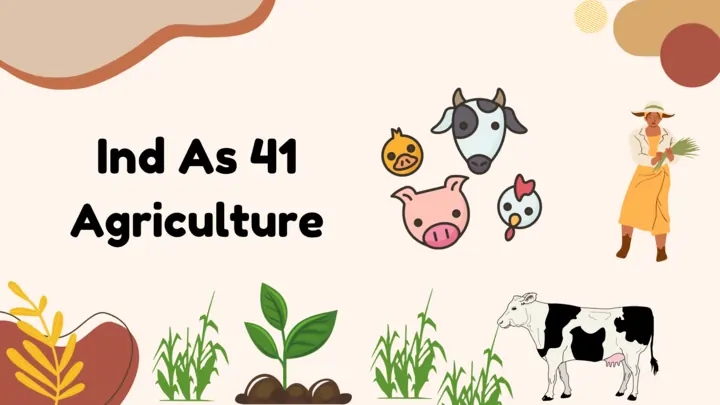Table of Contents
IND AS 41 – Agriculture provides guidance on the accounting and reporting of agricultural activities, including the recognition, measurement, and disclosure of agricultural assets and agricultural produce. Here are some key points to consider:

Scope and objective:
IND AS 41 applies to agricultural activities, which include the cultivation of plants (such as crops and trees) and the rearing of animals (such as livestock). It covers both biological assets (living plants and animals) and agricultural produce (harvested produce from biological assets).
Agricultural Activities:
The scope of IND AS 41 encompasses various agricultural activities, including the cultivation of crops, rearing of livestock, and forestry operations. It applies to both commercial and subsistence farming activities.
Measurement of Biological Assets:
Biological assets are living plants and animals used in agricultural production. IND AS 41 defines specific criteria for recognizing and measuring these assets. Biological assets are initially measured at cost, which includes all directly attributable costs necessary to bring the asset to its present location and condition.
Subsequently, biological assets are measured at fair value less estimated point-of-sale costs, unless fair value cannot be reliably measured, in which case they are measured at cost less accumulated depreciation and impairment. IND AS 41 provides guidance on how to determine fair value, considering factors such as market prices, biological asset characteristics, and supply and demand conditions.
IND AS 16 applies to bearer plants themselves, the accounting treatment for the produce on bearer plants is governed by IND AS 41. It’s essential to consider both standards in order to appropriately account for both the bearer plants and their associated produce.
Harvested Agricultural Produce:
Once agricultural produce is harvested, it is no longer classified as a biological asset but as a product of agricultural activity. The harvested produce is measured at fair value less estimated point-of-sale costs at the point of harvest. Subsequent changes in fair value are recognized in profit or loss.
Government Grants:
When agricultural entities receive government grants related to biological assets, they are recognized initially at fair value and then measured at their cost. The grants are recognized as income over the period necessary to match them with the costs they are intended to compensate. Subsequently, the grants are recognized in profit or loss over the period that matches the costs they are intended to compensate.
Recognition of Gains or Losses:
Gains or losses arising from changes in the fair value of biological assets are recognized in profit or loss, except when fair value cannot be reliably measured, in which case they are recognized in equity until the asset is harvested or disposed of.
Applicability to Agriculture-related Activities:
IND AS 41 also provides guidance on the accounting treatment of agricultural produce when it undergoes further processing, such as the conversion of milk into cheese or the pressing of grapes into wine. The accounting for these activities depends on whether they result in new agricultural produce or a different product altogether.
Applicability to Different Industries:
IND AS 41 is not limited to traditional farming activities but also extends to other sectors where biological transformation takes place, such as fish farming, orchards, and timber production. The standard ensures consistency in the accounting treatment of agricultural activities across various industries.
Disclosure Requirements:
IND AS 41 requires comprehensive disclosures related to agricultural activities. This includes information on the measurement bases used, the quantities of biological assets, changes in fair value, the existence and terms of any biological assets pledged as security, and any government grants received.
Conclusion:
IND AS 41 provides a framework for the accounting and reporting of agricultural activities. It ensures that entities involved in agriculture accurately measure and present their biological assets and agricultural produce in their financial statements. By adhering to the principles of IND AS 41, entities can provide transparent and reliable information about their agricultural operations, enabling stakeholders to make informed decisions and assess the financial performance and position of the entity.
FAQ:
How does Ind AS 41 define agricultural activity?
It defines agricultural activity as the management of the biological transformation and harvest of biological assets for sale, as well as the management of agricultural produce and the acquisition of biological assets for production or sale.
How are biological assets measured under this Ind AS?
Biological assets are initially measured at fair value less estimated point-of-sale costs. Subsequently, they are measured at fair value less estimated costs to sell, unless the fair value is not reliably determinable, in which case they are measured at cost less accumulated depreciation and impairment losses.
Does this standard provide guidance on the accounting for government grants related to agricultural activity?
Yes, Ind AS 41 provides guidance on the accounting for government grants related to agricultural activity, including the recognition, measurement, and presentation of such grants in the financial statements.
How does this Ind AS handle the treatment of agricultural produce harvested from an entity’s own biological assets?
It requires agricultural produce harvested from an entity’s own biological assets to be measured at its fair value less estimated point-of-sale costs at the point of harvest. Any change in fair value after harvest is recognized in profit or loss.